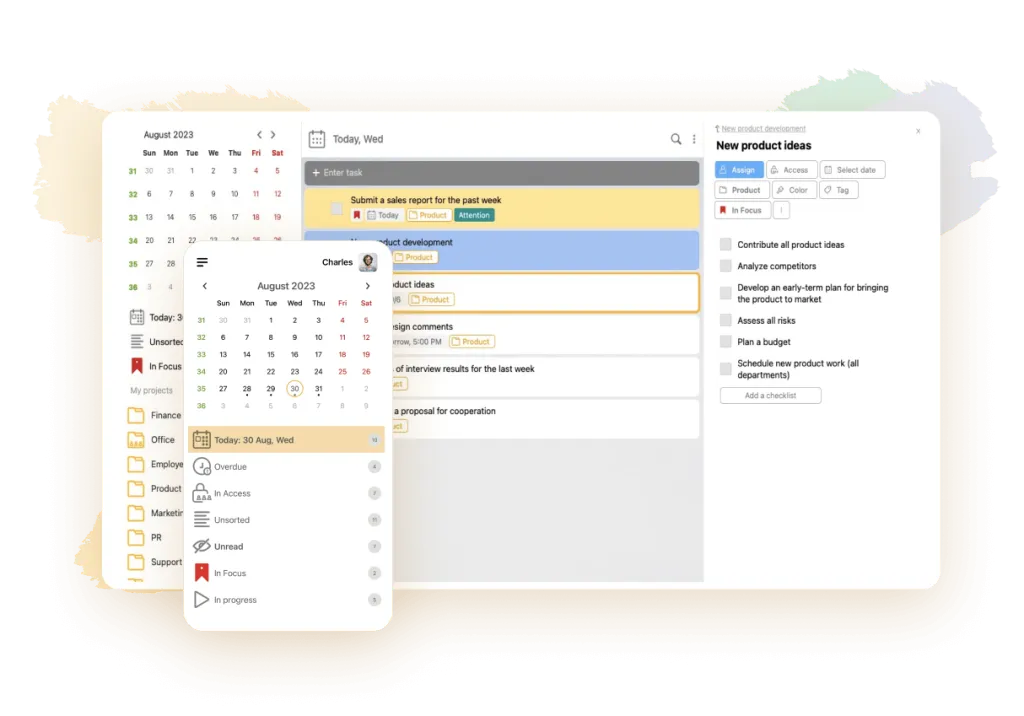
Ted Scott
March 20, 2024
The Eisenhower matrix (or prioritization matrix or Eisenhower square) is an effective tool used in planning. The method minimizes planning time, makes it easier and faster.
In today’s article we will consider the essence and features of this principle of time management and find out what its structure is. And we will also learn what the essence of the Eisenhower matrix is, what criteria it has, how it is applied at work and at home. We want to understand and tell you how to correctly set tasks and present ready-made examples.
What is Eisenhower matrix: definition
U.S. General and politician Dwight Eisenhower was best known as the 34th President of the United States from 1953 to 1961. The intense activity and continuous professional employment forced the commander to focus on a variety of tasks every day.
According to history, in order to optimize this process, the politician came up with a unique method of time planning, which later became known as the Eisenhower matrix. Today, this model can be used not only by commanders-in-chief, but even by ordinary people: managers, employees, freelancers, housewives. It is a simple but effective way to effectively prioritize current tasks, quickly put things in order and achieve success.
The meaning of the approach lies in the competent division of tasks: the ability to understand and distinguish the important and urgent from the less important and urgent. In addition, with this method, it is possible to significantly reduce the time spent on unimportant, meaningless activities.
How to apply the matrix
This popular time management tool helps you to evaluate the importance of your own daily tasks and categorize them in detail. All tasks according to this matrix are divided into 4 groups, distributed vertically and horizontally - importance and urgency. Depending on their intersection, they appear:
-
Group A - urgent and important matters.
-
Group B - non-urgent and important tasks.
-
Group C - urgent and unimportant assignments.
-
Group D - non-urgent and unimportant actions.
Filling in and dividing all tasks into groups allows you to filter out minor and insignificant tasks that need to be solved, which are important and valuable for a person. With the help of the matrix, creating lists of tasks becomes easier and it becomes possible to focus on what is necessary at a given moment.
Structure of the Eisenhower matrix
It consists of four small fields named A, B, C, D. To build it, draw a square with four equal sectors. Then make a complete list of actual tasks that need to be accomplished. After that, the tasks should be distributed into sectors according to the degree of importance and urgency. In this case, square A includes urgent and important tasks, B - important and non-urgent, C - unimportant and urgent, D - unimportant and non-urgent.
Square A (emergency, crisis)
Quadrant A contains important and urgent tasks that are recommended to be done immediately, as they become available. In people with time management skills, this quadrant looks empty most of the time. The constant presence of tasks in this field indicates that the person has problems with planning, delegation and dispersal of forces, or incorrect prioritization.
Which cases are usually recorded in field A:
-
force majeure;
-
health-related;
-
having a negative impact on other cases if not fulfilled;
-
leading to trouble for non-compliance;
-
sudden and favorable opportunities that should not be missed.
In order that the tasks in quadrant A do not arrive, it is necessary to perform tasks from quadrant B in a timely manner. Also for the fastest resolution of these tasks, their fulfillment can be delegated, but only to responsible and trusted people. At the same time, delaying the execution of assignments from quadrant A is often accompanied by stress, anxiety or emotional “burnout” of a person.
Square B (strategic, potential)
This is the most important element that is worthy of utmost attention. In this field there are things that are necessary and belong to the priority, perspective and allow a person to develop in the long term. People who devote the most time to tasks from sector B, organize their lives around them, more often achieve success in career, move up the career ladder faster, get more money, live happier and brighter.
This usually includes high-impact cases such as:
-
academic, professional and sporting activities;
-
self-development and self-education activities (reading, courses, etc.);
-
search for new opportunities, personal projects and realization of business ideas;
-
adherence to an acceptable daily schedule, dietary regimen;
-
medical examinations, taking tests and regular check-ups with doctors, dentists, psychologists and other specialists;
-
planning, analyzing work, etc.
Some things from sector B, which have not been given proper attention for a long time, can move to square A. For example, if you refuse to go to the dentist for a long time, you may wake up one day with a very severe toothache that can no longer be ignored. Moreover, the task risks turning into a problem: the tooth may completely collapse, rot and require extraction or expensive treatment.
Square C (sector of disturbances, vanity, illusions)
This field contains activities that keep you busy all the time, but do not bring you closer to your goal setting or help you to know more, develop and become better in personal and business terms. These include, for example, tasks such as:
-
mailing out documents, checking e-mail;
-
cleaning, cooking, washing dishes;
-
repairs, mowing the lawn, fixing an electric stove or washing machine, etc.
Most of the tasks in the third list are the most important part of our life, so it is not possible to completely disconnect from them. However, when a person performs mostly such tasks, his dissatisfaction with his life grows and he feels that he is doing the wrong thing.
Therefore, it is recommended to delegate these tasks to a personal assistant, contractor, cleaning, repair or delivery service. If reassigning tasks from List C is still impossible or unavailable for a number of reasons, you should reduce their impact on your schedule. For example, limit visits to messengers, turn off notifications, and say “no” more often.
You should also proceed to the tasks from the third field of the table only when the tasks from the previous two sectors have already been completed.
Square D (sector of destruction, waste, garbage)
The most paradoxical field in the table, as it includes favorite activities, but which are of no benefit to the individual. For example, it includes such tasks as:
-
talk on the phone, meet friends in a café, play golf or billiards with your mates;
-
play a console or computer game, watch a TV show, read a book;
-
log into a social network, check messenger, reply to a message, etc.
The desire to be lazy, relax and socialize with loved ones is nice, but is not practical in the long run, kills time, and prevents you from achieving an important goal.
Of course, it is necessary to rest, but if these tasks are the majority and the main focus of the person, he can get stuck in a routine. In this case, the individual’s overall motivation to do something drops, stress, procrastination and a sense of escapism arise.
The best remedy in this case is to record and identify what from the list in sector D takes up the most time. And then try to limit or replace it with a more productive activity, for example, a task from sector B - yoga, meditation, learning a foreign language, listening to music, sports. A drawing of Stephen Covey’s technique, similar to a coordinate system, is attached below.
Advantages and disadvantages
U.S. President Dwight Eisenhower’s Priority Matrix is a common method of time management, which, along with other methods of time management, has not only pluses but also minuses. Let’s consider them in a little more detail.
| Pros | Minuses |
|---|---|
| ease of use - does not require special knowledge, prior detailed training on application; | the way only makes sense if one has a daily routine; |
| versatility - quickly and easily fits into the life of any person, any sphere of activity; | is not suitable for long-term planning; |
| no complexities, no additional tools, no auxiliary settings - you just need to make a list of current tasks and allocate them to sectors; | ranking of current tasks is subjective, so it may be performed with errors; |
| instant identification of the right development strategy - immediately after structuring the tasks by quadrants in the matrix, it becomes clear what needs to be done at a given moment; | does not take into account external factors, environment, other people, etc. |
| quick identification of shortcomings and errors - immediately after the matrix is created, you will see which cases take too much time or do not need to be solved, taking a lot of time and effort at the moment. |
Thus, the Eisenhower matrix as a prioritization tool, although it is a wand for short-term planning and urgency, but in some cases it will be ineffective. Take these parameters into account when making the table.
Suitable for
The Eisenhower matrix can be used by absolutely any person both in everyday life, for self-improvement, goal-setting, and in professional activities for self-management. The method fits perfectly and easily into the solution of collective projects, individual planning of work tasks. In addition, it allows you to quickly solve routine, everyday, personal issues.
Therefore, this expedient method is perfect for any person who wants to learn how to properly and effectively plan their working and personal time. It will also be useful to anyone who wants to perform tasks urgently, efficiently and effectively, get rid of a huge list of things to do, sort the important from the unnecessary, free up time for leisure and family.
LeaderTask is an app for setting goals and objectives according to the Eisenhower matrix

Today there are quite a few electronic tools available to simplify and optimize rap scheduling. These include the convenient and modern LeaderTask service. It consists of a complete set of tools, functions and means for planning, including those based on the priority method.
The application helps you create lists of scheduled tasks and notes, change the order of tasks, sort them by priority or value, delete completed tasks, adjust the conditions of their execution or change the dates. In addition, LeaderTask has a clear interface, keeps notes in different categories, colors and themes.
The program can be used in shared and individual access in both online and offline modes. It synchronizes perfectly on different devices, works on all existing operating systems, has a browser and mobile version.
Conclusion
When skillfully used, the method allows you to effectively and competently manage time. After a week of daily use of this tool, each person will notice that he has time to do much more things, gains control over any tasks.
In addition, the matrix can be used productively both on paper and in a special LeaderTask application. It can be used both for routine duties, self-development issues, and a whole range of career-related tasks.
To summarize, this method is a great way to manage your own life, which at the same time allows you to cope with emotional and professional burnout, to start enjoying your work and everyday life.








